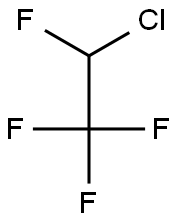
Chlorotetrafluoroethane
- русский язык имя
- английское имяChlorotetrafluoroethane
- CAS №63938-10-3
- CBNumberCB6852139
- ФормулаC2HClF4
- мольный вес136.4759528
- EINECS264-567-8
- файл Mol63938-10-3.mol
химическое свойство
| Температура кипения | -14.08°C (rough estimate) |
| плотность | 1.3640 (estimate) |
| показатель преломления | 1.3022 (estimate) |
| FDA UNII | 6272DG9IPQ |
| Система регистрации веществ EPA | Chlorotetrafluoroethane (63938-10-3) |
| Банк данных об опасных веществах | 63938-10-3(Hazardous Substances Data) |
рисовальное письмо(GHS)
-
рисовальное письмо(GHS)

-
сигнальный язык
опасность
-
вредная бумага
H280:Газ под давлением. Баллоны (емкости) могут взрываться при нагревании.
-
оператор предупредительных мер
P410+P403:Беречь от солнечных лучей. Хранить в хорошо вентилируемом месте.
Chlorotetrafluoroethane химические свойства, назначение, производство
Общее описание
1-Chloro-1,2,2,2,-tetrafluoroethane is a colorless odorless gas. Chlorotetrafluoroethane is shipped as a liquefied gas under its own vapor pressure. Chlorotetrafluoroethane can asphyxiate by the displacement of air. Contact with the liquid can cause frostbite. Exposure of the container to prolonged heat or fire can cause Chlorotetrafluoroethane to rupture violently and rocket.Профиль реактивности
Chlorotetrafluoroethane is chemically inert in many situations, but can react violently with strong reducing agents such as the very active metals and the active metals. Can react with strong oxidizing agents or weaker oxidizing agents under extremes of temperature.Угроза здоровью
Displaces air such that oxygen content may become too low to support life. Prolonged exposure can cause narcotic effect or rapid suffocation. Contact with liquid may cause frostbite.Пожароопасность
Some may burn but none ignite readily. Containers may explode when heated. Ruptured cylinders may rocket.